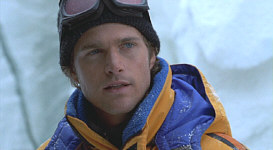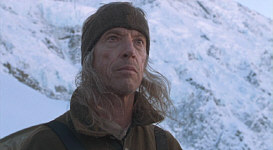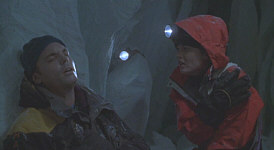Reviewed by Colin Jacobson
 If I ever get the chance to direct a big-budget action flick, remind me not to hire Robin Tunney. Oh, I have nothing against the actress; she seems to be a competent performer, and she certainly can look easy on the old peepers. However, it appears that every time she graces a motion picture screen, the movie tanks. A look over her résumé reveals a list of dogs: The Craft maintained a decent cult following, as did Empire Records, but Tunney’s big budget offerings - End of Days and Supernova - have been total duds.
If I ever get the chance to direct a big-budget action flick, remind me not to hire Robin Tunney. Oh, I have nothing against the actress; she seems to be a competent performer, and she certainly can look easy on the old peepers. However, it appears that every time she graces a motion picture screen, the movie tanks. A look over her résumé reveals a list of dogs: The Craft maintained a decent cult following, as did Empire Records, but Tunney’s big budget offerings - End of Days and Supernova - have been total duds.
But perhaps I shouldn’t put the blame on Tunney, as co-star Chris O’Donnell hasn’t exactly figured out a way to mint box office gold. Sure, some of his movies have done pretty nicely; Scent of a Woman and Batman Forever both took in solid amounts of cash. However, those put O’Donnell in a supporting capacity, and he hasn’t been able to generate much excitement as a lead actor; from The Chamber to The Bachelor to pretty much all the rest, he has yet to star in a real hit.
Perhaps the presence of these two doomed the 2000 mountain-climbing action flick Vertical Limit, but one might think that they were balanced out by the other participants. Limit was directed Martin Campbell, who brought Bond back to prominence with 1995’s GoldenEye and also did well with 1998’s Mask of Zorro.
In addition, Limit featured some powerful supporting actors. Scott Glenn has hits like The Silence of the Lambs, The Hunt for Red October, and The Right Stuff under his belt, and then there’s Bill Paxton. Few actors have shown up in as many mega-hits as has Paxton. Not only did he perform in solid winners like Twister, Apollo 13, Aliens, True Lies and The Terminator, he also made it into the highest grossing film of all-time, 1997’s Titanic!
 I guess that magnetism couldn’t overcome Limit’s negatives. Despite some positive advance word and a cushy holiday release spot, the film failed to perform at the box office. Its ultimate take of $68 million wasn’t a terrible gross, but considering the movie’s budget of $75 million, the result had to be a disappointment.
I guess that magnetism couldn’t overcome Limit’s negatives. Despite some positive advance word and a cushy holiday release spot, the film failed to perform at the box office. Its ultimate take of $68 million wasn’t a terrible gross, but considering the movie’s budget of $75 million, the result had to be a disappointment.
Sometimes terrific movies fail to find an audience, so the mediocre gross of Limit didn’t necessarily connote a weak project. Or maybe it did. While Vertical Limit isn’t a bad movie, it certainly is a bland and lifeless action flick that failed to distinguish itself from the pack.
At the start of the film, we meet the Garrett family, a mountain-climbing clan. There’s dad Boyce (Stuart Wilson) plus kids Peter (O’Donnell) and Annie (Tunney). Early in the flick, disaster accompanies one climb and Peter has to cut Dad free so he and Annie can survive. Years after the event, the siblings’ relationship has become estranged. Peter no longer climbs, while Annie has become a star in the sport.
Their paths cross when both work on K2, known as the world’s most deadly peak. Peter’s doing research, while Annie’s part of an expedition hired by eccentric mogul Elliott Vaughn (Paxton); he wants to make it to the top of K2 to promote his airline. Inevitably, matters go awry, and after a storm strikes, only three climbers - Annie, Vaughn and guide Tom McLaren (Nicolas Lea) remain alive.
 With that group in bad shape, most of the folks still at base camp figure they’re as good as dead, but Peter refuses to give up hope. As such, he cobbles together a team of his own to find and rescue the survivors. Sexy Monique (Izabella Scorupco) wants to collect a big payday offered by Vaughn’s assistant, while two crazy Aussie brothers, Cyril and Malcolm Bench (Steve Le Marquand and Ben Mendelsohn) just want a wild experience. Aziz (Augie Davis) comes along because he hopes a relative has survived the storm, while legendary mountain man Montgomery Wick (Glenn) has some dark reasons of his own to come along for the ride.
With that group in bad shape, most of the folks still at base camp figure they’re as good as dead, but Peter refuses to give up hope. As such, he cobbles together a team of his own to find and rescue the survivors. Sexy Monique (Izabella Scorupco) wants to collect a big payday offered by Vaughn’s assistant, while two crazy Aussie brothers, Cyril and Malcolm Bench (Steve Le Marquand and Ben Mendelsohn) just want a wild experience. Aziz (Augie Davis) comes along because he hopes a relative has survived the storm, while legendary mountain man Montgomery Wick (Glenn) has some dark reasons of his own to come along for the ride.
As the team tries to locate and save the survivors, they encounter a ridiculous number of obstacles, all of which endanger the participants. Who’ll make it back and who won’t? I’ll leave those details out of my review; suffice it to say that few can survive… the vertical limit!
I suppose that mountain climbing may still produce a good movie someday, but between
Cliffhanger, no one’s yet come close. At least Limit took the more realistic approach. While it clearly takes many liberties with the subject, it comes across as less campy and absurd when compared to the 1993 Sylvester Stallone vehicle; that one stamped an action/robbery plot onto its setting. Limit provides an outlandishly improbable set of obstacles for its protagonists and also ignores a number of physical laws, but I preferred the basic concept in which a rescue generates, not some silly cops and robbers deal.
 Nonetheless, I didn’t care much for Limit, and it still suffers from a lot of the problems that plagued Cliffhanger. Both movies lacked character and they felt like little more than a compendium in stunts in search of some humanity. None of Limit participants seemed like full-fledged people. Glenn and Paxton add some spark to their roles, but both are underwritten and generally uncompelling, while Tunney and O’Donnell failed to make an impact with their characters. Both should really be haunted by their tragic past, but we never sense that as they stomp through their lives.
Nonetheless, I didn’t care much for Limit, and it still suffers from a lot of the problems that plagued Cliffhanger. Both movies lacked character and they felt like little more than a compendium in stunts in search of some humanity. None of Limit participants seemed like full-fledged people. Glenn and Paxton add some spark to their roles, but both are underwritten and generally uncompelling, while Tunney and O’Donnell failed to make an impact with their characters. Both should really be haunted by their tragic past, but we never sense that as they stomp through their lives.
Director Campbell doesn’t do much to elaborate on any of these elements either. The emphasis is firmly on action, action, action, with little time for any niceties such as plot or character. Admittedly, many of the action sequences are very well-executed and exciting, and the movie occasionally shows some signs of life. However, the generally anonymous tone undermines these moments and makes them less potent than they could have been.
Some surprisingly weak visual effects work also took me out of the story. When done right, computer generated imagery can provide a seamless and intensely realistic setting for a film. For example, as I watched Cast Away, I almost never had the slightest clue I saw anything other than real footage; I was shocked to learn how much of the movie featured computer graphics.
 No such surprise accompanied my viewing of Vertical Limit. Instead, I was appalled to see how fake looking so much of the film was. Most of the time when we see our actors on cliffs, it seems dreadfully obvious that they’re on soundstages and digital footage has been inserted around them. Even close-ups that feature no computer backgrounds take on this artificial appearance, and these aspects of the movie made it difficult for me to take it seriously. Granted, I know that the production wouldn’t risk the lives of its actors by putting them on the sides of mountains, but well-integrated effects would at least make me suspend my disbelief; the weak images of Limit led me to continually remember that I was watching a movie.
No such surprise accompanied my viewing of Vertical Limit. Instead, I was appalled to see how fake looking so much of the film was. Most of the time when we see our actors on cliffs, it seems dreadfully obvious that they’re on soundstages and digital footage has been inserted around them. Even close-ups that feature no computer backgrounds take on this artificial appearance, and these aspects of the movie made it difficult for me to take it seriously. Granted, I know that the production wouldn’t risk the lives of its actors by putting them on the sides of mountains, but well-integrated effects would at least make me suspend my disbelief; the weak images of Limit led me to continually remember that I was watching a movie.
I can’t say I truly disliked the time I spent with Vertical Limit, as the film had enough exciting set pieces to make it moderately entertaining at times. However, this was at best a mediocre action flick that never did much to rise to a higher level. While some parts of it came across well, too much of it seemed bland and pedestrian; little about the movie stood out from the crowd.



